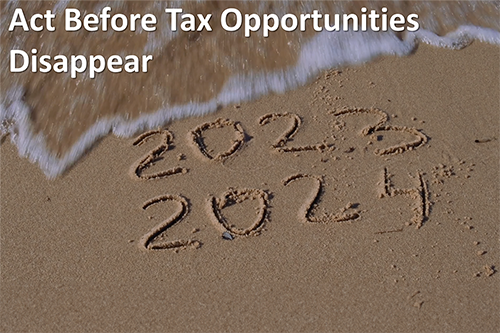
Year-end tax planning in 2023 can make a big financial difference in retirement funding and how much you leave your heirs. Here are some tips, situations, and useful ideas written by a real human with decades of experience in year-end tax planning maneuvers.
Back-Door Roth IRAs. Roth IRAs, if you follow the complicated rules, provide tax-free income in retirement. In addition, they can offer your heirs favorable tax treatment by naming them as beneficiaries. However, high-income earners cannot contribute to a Roth IRA account if they earn more than $228,000 in 2023 and file jointly ($153,000 for single filers). The back-door route sidesteps the income limits. Taking the back-door route is a completely legal method under IRS rules. Instead of contributing directly to a Roth IRA account, a three-step process is involved: (1) contribute to a traditional IRA account, (2) withdraw all or part of the traditional IRA account and pay income taxes on the withdrawal, and (3) place the amount withdrawn in a Roth IRA account. Paying income tax on the amount withdrawn from the traditional IRA may be a bitter pill to swallow right now, but it converts that amount to a tax-free account. The limits are based on modified adjusted gross income.
College Funding Overachievers. Parents and grandparents who saved more than what’s needed in a 529 College Savings Plan account can convert the leftover amount to a Roth IRA. When a child gets a scholarship or elects to attend a state school with low tuition, the assets are eligible to be transferred to a tax-free Roth IRA. Up to $35,000 of 529 assets left over after a child attends undergraduate and graduate studies can be placed in a Roth IRA account, where it will never again be taxed, according to federal tax law.
Think Ahead. Reducing federal taxes in 2023 and 2024 depends largely on what’s going on in your life. Do you have a wedding coming up? Expecting a grandchild in 2024? Are you changing jobs? Planning for personal and job changes is one of the benefits of our advice. For instance, planning a large withdrawal to pay for a wedding in 2024 lets you plan to raise cash slowly. This could be better financially than making one large withdrawal all at once, since stock and bond prices are volatile.
Although the end of this year is more than four months away, these three year-end planning tax tips require serious attention and beginning sooner is smart. We’ll have more year-end tax tips next week, unless more important personal financial and tax planning news breaks.

